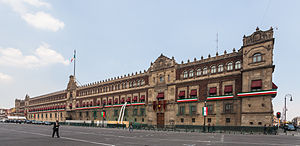National Palace (Mexico)
| National Palace | |
|---|---|
| Palacio Nacional | |

The National Palace in Mexico City
|
|
|
|
|
| General information | |
| Location | Mexico City, Mexico |
| Coordinates | 19°25′57″N 99°7′52″W / 19.43250°N 99.13111°WCoordinates: 19°25′57″N 99°7′52″W / 19.43250°N 99.13111°W |
The National Palace (Palacio Nacional in Spanish) is the seat of the federal executive in Mexico. It is located on Mexico City's main square, the Plaza de la Constitución (El Zócalo). This site has been a palace for the ruling class of Mexico since the Aztec empire, and much of the current palace's building materials are from the original one that belonged to Moctezuma II.
Used and classified as a Government Building, the National Palace, with its red tezontle facade, fills the entire east side of the Zócalo, measuring over 200 meters long. It is home to some of the offices of both the Federal Treasury and the National Archives.
The facade is bordered on the north and south by two towers and include three main doorways, each of which lead to a different part of the building. The southern door leads to the Patio of Honor and presidential offices (no public access). The northern door is known as the Mariana Door, named in honor of Mariano Arista who had it constructed in 1850. The area next to this door used to be the old Court Prison, with courtrooms and torture chambers. It is now occupied by the Finance Ministry. It contains the Treasury Room, constructed by architects Manuel Ortiz Monasterio and Vicente Mendiola. The iron and bronze door is the work of Augusto Petriccioli.
Above the central doorway, facing the Zócalo, is the main balcony where just before 11pm on September 15, the president of Mexico gives the Grito de Dolores, in a ceremony to commemorate Mexican Independence. Part of this ceremony includes ringing the bell that hangs above the balcony. This bell is the original one that Father Miguel Hidalgo rang to call for rebellion against Spain. It originally hung in the church of Dolores Hidalgo, Guanajuato, but was relocated here. In the niche containing the bell, there is the Mexican coat of arms. On each side there is an Aztec eagle knight and his Spanish counterpart. These were sculpted by Manuel Centurion and symbolize the synthesis of Mexican culture and Spanish culture.
...
Wikipedia

